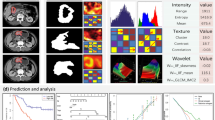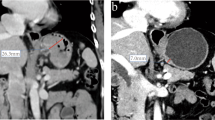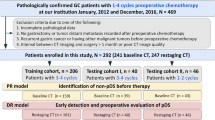Abstract
Background and objective
No effective preoperative tool is available for predicting the prognosis of advanced gastric cancer (AGC) treated by neoadjuvant chemotherapy (NAC). We aimed to explore the association between change values (“delta”) in the radiomic signatures of computed tomography (CT) (delCT-RS) before and after NAC for AGC and overall survival(OS).
Methods and design
A total of 132 AGC patients with AGC were studied as a training cohort in our center, and 45 patients from another center were used as an external validation set. A radiomic signatures-clinical-nomogram(RS-CN) was established using delCT-RS and preoperative clinical variables. The prediction performance of RS-CN was evaluated using the area under the receiver operating characteristic (ROC)curve (AUC values), time-dependent ROC, decision curve analysis(DCA) and C-index.
Results
Multivariable Cox regression analyses showed that delCT-RS, cT-stage, cN-stage, Lauren-type and the value of variation of carcinoma embryonic antigen (CEA) between NAC were independent risk factors for 3-year OS of AGC. In the training cohort, RS-CN had a good prediction performance for OS (C-Index 0.73) and AUC values were significantly better than those of delCT-RS, ypTNM-stage and tumor regression grade(TRG) (0.827 vs 0.704 vs 0.749 vs 0.571, p < 0.001). DCA and time-dependent ROC of RS-CN were better than those of ypTNM stage, TRG grade and delCT-RS. The prediction performance of the validation set was equivalent to that of the training set. The cut-off (177.2) of RS-CN score was obtained from X-Tile software, a score of > 177.2 was defined as high-risk group(HRG), and scores of ≤ 177.2 were defined as the low-risk group(LRG). The 3-year OS and disease free survival(DFS) of patients in the LRG were significantly better than those in the HRG. Adjuvant chemotherapy(AC) can only significantly improve the 3-year OS and DFS of the LRG. (p < 0.05).
Conclusions
Our nomogram based on delCT-RS has good prediction of prognosis before surgery and helps identify patients that are most likely to benefit from AC. It works well in precise and individualised NAC in AGC.






Similar content being viewed by others
Availability of data and materials
The datasets used and/or analyzed during the current study are available from the corresponding author on reasonable request.
Abbreviations
- AGC:
-
Advanced gastric cancer
- cT-stage:
-
Clinical T stage according to American Joint Committee on Cancer (AJCC) staging system for gastric Cancer (AJCC 8th)
- cN-stage:
-
Clinical N stage according to American Joint Committee on Cancer (AJCC) staging system for gastric Cancer (AJCC 8th)
- OS:
-
Overall Survival
- DFS:
-
Disease free survival
- CEA:
-
Carcinoma embryonic antigen
- NAC:
-
Neoadjuvant chemotherapy
- AC:
-
Adjuvant chemotherapy
- YpT:
-
Tumor (T pathological stage) after neoadjuvant chemotherapy
- YpN:
-
Nodes pathological stage after neoadjuvant chemotherapy.
- BMI:
-
Body Mass Index
- ECOG:
-
Eastern Cooperative Oncology Group
- LN:
-
Lymph node
- RECIST:
-
Response evaluation criteria in solid tumors
- AUC:
-
Area under the curve
- ROC:
-
Receiver operating characteristic
- TRG:
-
Tumor regression grade
- Time-dependent ROC:
-
Incorporated time dependency of area under the curve of ROC
- DCA:
-
Decision curve analysis
- ICC:
-
Intraclass correlation coefficient
- CT:
-
Computed tomography
- ROI:
-
Region of interest
- GLCM:
-
Gray-level co-occurrence matrix
- GLDM:
-
Gray-level dependence matrix
- GLSZM:
-
Gray-level size zone matrix
- GLRLM:
-
Gray-level run length matrix
- CT-RS:
-
CT-based radiomics features scores
- RS-CN:
-
Radiomic signatures-clinical-nomogram
References
Sung H, Ferlay J, Siegel RL et al (2021) Global cancer statistics 2020: globocan estimates of incidence and mortality worldwide for 36 cancers in 185 countries. CA Cancer J Clin 71:209–249. https://doi.org/10.3322/caac.21660
Wilke H, Preusser P, Fink U et al (1989) Preoperative chemotherapy in locally advanced and nonresectable gastric cancer: a phase II study with etoposide, doxorubicin, and cisplatin. J Clin Oncol. https://doi.org/10.1200/JCO.1989.7.9.1318
Smyth EC, Fassan M, Cunningham D et al (2016) Effect of pathologic tumor response and nodal status on survival in the medical research council adjuvant gastric infusional chemotherapy trial. J Clin Oncol 34:2721–2727. https://doi.org/10.1200/JCO.2015.65.7692
Zhang X, Liang H, Li Z et al (2021) Perioperative or postoperative adjuvant oxaliplatin with S-1 versus adjuvant oxaliplatin with capecitabine in patients with locally advanced gastric or gastro-oesophageal junction adenocarcinoma undergoing D2 gastrectomy (Resolve): an open-label, superiority and non-inferiority, phase 3 randomised controlled trial. Lancet Oncol 22(8):1081–1092. https://doi.org/10.1016/S1470-2045(21)00297-7
Wagner AD, Syn NL, Moehler M et al (2017) Chemotherapy for advanced gastric cancer. Cochrane Database Syst Rev 8(8):CD004064. https://doi.org/10.1002/14651858.CD004064.pub4
Ychou M, Boige V, Pignon J-P et al (2011) Perioperative chemotherapy compared with surgery alone for resectable gastroesophageal adenocarcinoma: an FNCLCC and FFCD multicenter phase III trial. J Clin Oncol 29(13):1715–1721. https://doi.org/10.1200/JCO.2010.33.0597
Brierly JD, Gospodarowicz MK, Wittekind C (2017) TNM classification of malignant tumours edn 8. Wiley, Hoboken, NJ
Balachandran VP, Gonen M, Smith JJ et al (2015) Nomograms in oncology: more than meets the eye. Lancet Oncol 16:e173–e180. https://doi.org/10.1016/S1470-2045(14)71116-7
Eisenhauera EA, Therasseb P, Bogaertsc J et al (2009) New response evaluation criteria in solid tumours: revised RECIST guideline (version 1.1). Eur J Cancer 45(2):228–247. https://doi.org/10.1016/j.ejca.2008.10.026
Lambin P, Leijenaar RTH, Deist TM et al (2017) Radiomics: the bridge between medical imaging and personalized medicine. Nat Rev Clin Oncol 14:749–762. https://doi.org/10.1038/nrclinonc.2017.141
Wu G, Jochems A, Refaee T et al (2021) Structural and functional radiomics for lung cancer. Eur J Nucl Med Mol Imaging 48(12):3961–3974. https://doi.org/10.1007/s00259-021-05242-1
Ajani JA, D’Amico TA, Bentrem DJ (2022) Gastric cancer, version 2. 2022 NCCN clinical practice guidelines in oncology. J Natl Compr Canc Netw 20(2):167–192. https://doi.org/10.6004/jnccn.2022.0008
Huang Y, Liang CC, He L et al (2016) Development and validation of a radiomics nomogram for preoperative prediction of lymph node metastasis in colorectal cancer. J Clin Oncol 34:2157–2164. https://doi.org/10.1200/JCO.2015.65.9128
Braman NM et al (2017) Intratumoral and peritumoral radiomics for the pretreatment prediction of pathological complete response to neoadjuvant chemotherapy based on breast DCE-MRI. Breast Cancer Res 19(1):57. https://doi.org/10.1186/s13058-017-0846-1
Khorrami M, Khunger M, Zagouras A (2019) Combination of peri- and intratumoral radiomic features on baseline CT scans predicts response to chemotherapy in lung adenocarcinoma. Radiol Artif Intell. https://doi.org/10.1148/ryai.2019180012
Khorrami M, Jain P, Pingfu F et al (2019) Predicting pathologic response to neoadjuvant chemoradiation in resectable stage III non-small cell lung cancer patients using computed tomography radiomic features. J Lung Cancer. https://doi.org/10.1016/j.lungcan.2019.06.020
Dong D, Fang M-J, Tang L (2020) Deep learning radiomic nomogram can predict the number of lymph node metastasis in locally advanced gastric cancer: an international multi-center study. Ann Oncol 31(7):912–920. https://doi.org/10.1016/j.annonc.2020.04.003
Dong D, Fang M-J, Tang L et al (2020) Deep learning radiomic nomogram can predict the number of lymph node metastasis in locally advanced gastric cancer: an international multicenter study. Ann Oncol. 31(7):912–920. https://doi.org/10.1016/j.annonc.2020.04.003
Yu Y, Tan Y, Xie C (2020) Development and validation of a preoperative magnetic resonance imaging radiomics-based signature to predict axillary lymph node metastasis and disease-free survival in patients with early-stage breast cancer. JAMA Netw Open. https://doi.org/10.1001/jamanetworkopen.2020.28086
Koizumi W, Takiuchi H, Yamada Y et al (2010) Phase II study of oxaliplatin plus S-1 as first-line treatment for advanced gastric cancer (G-SOX study). Ann Oncol 21:1001–1005. https://doi.org/10.1093/annonc/mdp464
Koizumi W, Kim YH, Fujii M et al (2014) Addition of docetaxel to S-1 without platinum prolongs survival of patients with advanced gastric cancer: a randomized study (START). J Cancer Res Clin Onco 140:319–328. https://doi.org/10.1007/s00432-013-1563-5
De Vita F, Orditura M, Matano E et al (2005) A phase II study of biweekly oxaliplatin plus infusional 5-fluorouracil and folinic acid (FOLFOX-4) as first-line treatment of advanced gastric cancer patients. Br J Cance 92:1644–1649. https://doi.org/10.1038/sj.bjc.6602573
Al-Batran S-E, Homann N, Pauligk C et al (2019) Perioperative chemotherapy with fluorouracil plus leucovorin, oxaliplatin, and docetaxel versus fluorouracil or capecitabine plus cisplatin and epirubicin for locally advanced, resectable gastric or gastro-oesophageal junction adenocarcinoma (FLOT4): a randomised, phase 2/3 trial. Lancet 393(10184):1948–1957. https://doi.org/10.1016/S0140-6736(18)32557-1
Japanese Gastric Cancer Association (2011) Japanese classification of gastric carcinoma 3rd english edition. Gastric Cancer 14:101–112
Japanese gastric cancer treatment guidelines 2014 (ver 4) (2017) Gastric Cancer 20:1–19
Amin MB, Edge SB, Greene FL et al (2017) AJCC cancer staging manual, 8th edn. Springer, New York
Ronellenfitsch U, Schwarzbach M, Hofheinz R et al (2013) Preoperative chemo(radio)therapy versus primary surgery for gastroesophageal adenocarcinoma: systematic review with meta-analysis combining individual patient and aggregate data. Eur J Cancer 49(15):3149–3158. https://doi.org/10.1016/j.ejca.2013.05.029
Al-Batran S-E, Homann N, Pauligk C et al (2017) Effect of neoadjuvant chemotherapy followed by surgical resection on survival in patients with limited metastatic gastric or gastroesophageal junction cancer: the AIO-FLOT3 trial. JAMA Oncol 3:1237–1244. https://doi.org/10.1001/jamaoncol.2017.0515
Aoyama T, Nishikawa K, Fujitani K et al (2017) Early results of a randomized two-by-two factorial phase II trial comparing neoadjuvant chemotherapy with two and four courses of cisplatin/S-1and docetaxel/cisplatom/S-1 as neoadjuvant chemotherapy for locally advanced gastric cancer. Ann Oncol 28:1876–1881. https://doi.org/10.1093/annonc/mdx236
Grossmann P, Stringfield O, El-Hachem N et al (2017) Defining the biological basis of radiomic phenotypes in lung cancer. Elife. 6:e23421. https://doi.org/10.7554/eLife.23421
Chitalia RD, Kontos D (2019) Role of texture analysis in breast MRI as a cancer biomarker: a review. J Magn Reson Imaging. 49(4):927–938. https://doi.org/10.1002/jmri.26556
Braman NM, Etesami M, Prasanna P et al (2017) Intratumoral and peritumoral radiomics for the pretreatment prediction of pathological complete response to neoadjuvant chemotherapy based on breast DCE-MRI. Breast Cancer Res 19:57. https://doi.org/10.1186/s13058-017-0846-1
Wang WT, Yang L, Yang ZX et al (2018) Assessment of microvascular invasion of hepatocellular carcinoma with diffusion kurtosis imaging. Radiology 286:571–580. https://doi.org/10.1148/radiol.2017170515
Davies AR, Gossage JA, Zylstra J et al (2014) Tumor stage after neoadjuvant chemotherapy determines survival after surgery for adenocarcinoma of the esophagus and esophagogastric junction. J Clin Oncol Off J Am Soc Clin Oncol 32:2983–2990. https://doi.org/10.1200/JCO.2014.55.9070
Tokunaga M, Sato Y, Nakagawa M et al (2020) Perioperative chemotherapy for locally advanced gastric cancer in Japan: current and future perspectives. Surg Today 50:30–37. https://doi.org/10.1007/s00595-019-01896-5
Suenaga Y, Kanda M, Ito S et al (2019) Prognostic significance of perioperative tumor marker levels in stage II/III gastric cancer. World J Gastrointest Oncol 11(1):17–27. https://doi.org/10.4251/wjgo.v11.i1.17
Feng F, Tian Y, Xu G (2017) Diagnostic and prognostic value of CEA, CA19–9, AFP and CA125 for early gastric cancer. BMC Cancer 17:737. https://doi.org/10.1186/s12885-017-3738-y
Xiao J, Ye Z-S, Wei S-H (2017) Prognostic significance of pretreatment serum carcinoembryonic antigen levels in gastric cancer with pathological lymph node-negative: a large sample single-center retrospective study. World J Gastroenterol 23(48):8562–8569. https://doi.org/10.3748/wjg.v23.i48.8562
Sun K-Y, Hang-Tong Hu, Chen S-L (2020) CT-based radiomics scores predict response to neoadjuvant chemotherapy and survival in patients with gastric cancer. BMC Cancer 20(1):468. https://doi.org/10.1186/s12885-020-06970-7
Li Z, Xiao Q, Wang Y (2020) A Modified ypTNM staging system-development and external validation of a nomogram predicting the overall survival of gastric cancer patients received neoadjuvant chemotherapy. Cancer Manag Res 19(12):2047–2055. https://doi.org/10.2147/CMAR.S236696
H Kim, C M Park, SJ Park et al. Temporal Changes of Texture Features Extracted From Pulmonary Nodules on Dynamic Contrast-Enhanced Chest Computed Tomography: How Influential Is the Scan Delay? Invest Radiol. 2016 Sep;51(9):569–74. https://doi.org/10.1097/RLI.0000000000000267.
Funding
Fujian Key Minimally Invasive Medical Center NO. [2021] 662.
Author information
Authors and Affiliations
Contributions
Drs Shen LL and Zheng HL contributed equally to this work and should be considered first coauthors. Dr. Zheng CH had full access to all of the data in the study and take responsibility for the integrity of the data and the accuracy of the data analysis.
Corresponding author
Ethics declarations
Conflict of interest
None reported. There are no conflicts of interest or financial ties to disclose from any author.
Ethical standards
All procedures followed were in accordance with the ethical standards of the responsible committee on human experimentation (institutional and national) and with the Helsinki Declaration of 1964 and later versions. Informed consent or substitute for it was obtained from all patients for being included in the study.
Consent for publication
This article doesn’t report an individual participant's data in any form.
Additional information
Publisher's Note
Springer Nature remains neutral with regard to jurisdictional claims in published maps and institutional affiliations.
Supplementary Information
Below is the link to the electronic supplementary material.
Rights and permissions
Springer Nature or its licensor (e.g. a society or other partner) holds exclusive rights to this article under a publishing agreement with the author(s) or other rightsholder(s); author self-archiving of the accepted manuscript version of this article is solely governed by the terms of such publishing agreement and applicable law.
About this article
Cite this article
Shen, LL., Zheng, HL., Ding, FH. et al. Delta computed tomography radiomics features-based nomogram predicts long-term efficacy after neoadjuvant chemotherapy in advanced gastric cancer. Radiol med 128, 402–414 (2023). https://doi.org/10.1007/s11547-023-01617-6
Received:
Accepted:
Published:
Issue Date:
DOI: https://doi.org/10.1007/s11547-023-01617-6




